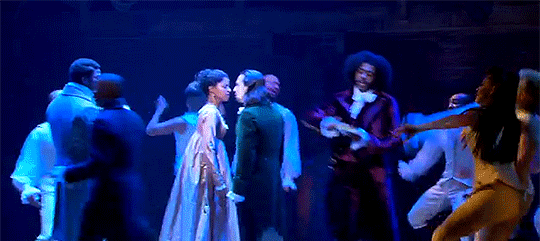For a show that might reshape the musical for the 21st century, there’s an awful lot of paper in Hamilton. The stage is a flurry of letters, ledgers, leaves and broadsides – it’s almost antiquated. Hamilton has sui generis swagger and the sound of something new, but it’s a story about what is written, what is read. It’s a show built on pen scratching furiously over paper.
In 2009, Lin-Manuel Miranda, the mensch of all our hearts, introduced a song from what was then a proposed concept album, saying Hamilton’s significance was in ‘the strength of his writing – he embodies the word’s ability to make a difference.’ As album grew into an all-consuming production, the act of writing remained integral: papers pass incessantly from hand to hand at high speed during the production. Alexander Hamilton – founding father, unsatisfied soul – scribbles policy, persuasion, passion and pique, to win a fight, woo a wife. He writes lofty, in the constitution; he writes low, to slap an enemy. He keeps records of slights and cheque stubs. In song, he’s a whirring wordsmith, but Miranda also makes him a slave to the pen.
Marks of heart and brain
Print engineered ideas during the revolutionary pamphlet wars. But what we see is handwritten – the mark of heart and brain on paper, issuing in the heat of the moment. People don’t waggle booklets, but scatter single sheets or pass them around like love letters. It keeps everything intimate, everything the issue of Hamilton’s teeming brain. He’s Washington’s writing-hand man, and even policy feels personal, a beef with Burr or Jefferson. Scribble, scribble, Mr Hamilton.
Spend an afternoon on pinterest, and you’ll see how Ham fans embrace this motif. Key lyrics are calligraphed on sepia backgrounds. They identify how everything in this show comes from and goes directly to the heart. None more so than in the myriad versions of the letter Hamilton sends to Angelica, the woman he might have married – addressed to not ‘My dearest Angelica’ but ‘My dearest, Angelica’. The comma speaks volumes, cracks open an unspoken love. ‘One stroke and you’ve consumed my waking days,’ she sings. Fans feel how that tiny mark on paper changes everything.
A highlight of a recent visit to the RSC’s props workshop was the ‘soft props’ corner, where paper becomes stageworthy. The level of detail was boggling – lovingly researched Victorian railway timetables or papal encyclical (Hilary Mantel had sent a letter of appreciation for Wolf Hall’s accurate documents). I was sat too far away to see if Hamilton’s papercraft followed suit: are these blank sheets, printed or penned (anyone who knows, please tell)?
Make way for the words
Is it heretical to wonder what a more assertive production of Hamilton might look like? Whatever you feel about 1980s behemoths by Lloyd Webber, Schönberg and Boublil, these productions rippled far beyond musical theatre. Trevor Nunn, Hal Prince, Nicholas Hytner and their design teams stamped emblematic images (chandelier, helicopter) on spectators’ brains; their choreographers, notably Gillian Lynne, turned movement into meaning. Filched from the bolder end of classical theatre, the style fed back into it tenfold. Mainstream Shakespeare, international opera, keen studio work were all transformed. A space dominated by a single theme- and story-telling element, hardwired with movement, became a prevailing style.
There’s none of that in Thomas Kail’s production of Hamilton. It makes way for the words – I’ve rarely listened so hard, so happily during a show. We mostly see someone standing centre stage, spinning fleet phrases and spitting puns, a twine of rhyme that keeps pulsing forward. What’s a director to do but ensure that nothing distracts? A polite timber set is reminiscent of the RSC’s duller history plays; sharp choreography is tightly confined – ripples and rucks that won’t pull focus.
Perhaps a staging of more invention would blow our tiny minds – it’s already hyperbolically exciting. As it is, paper fits right in. Audiences cherish this unlikely story as contemporary – we feel the zeal, we miss it in our public discourse. Miranda shows us our current moment, even as we see the first draft of history. It’s a reminder that history is process, never inevitable. It’s written, maybe forgotten, then rediscovered, like a pile of papers at the back of a drawer, personal to the writer and the eventual reader. No wonder we love Hamilton. Scribble, scribble.
Follow David on Twitter: @mrdavidjays


“…to win a fight, woo a wife.” You are rhyming, sir 🙂
It’s infectious (I hope someone stops me if it all gets too much).
You are good.
On a more serious note, I was thinking how shocking it was when [SPOILERS] Eliza was burning the letters. It’s not unusual but here it felt momentous.
Yes! Truly upsetting, for both of them.